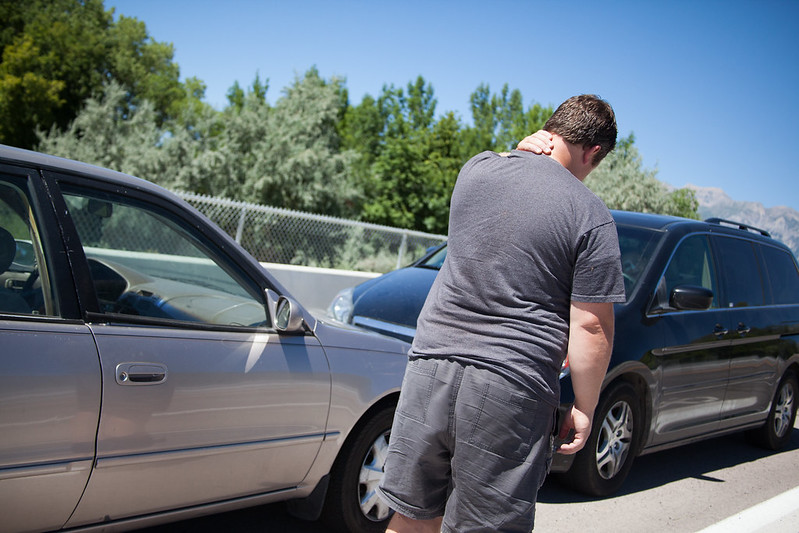
Understanding the common types of car wreck injuries can help you prepare for a possible collision. With 20 years of courtroom experience, I have represented families in cases involving serious car wreck injuries. I have witnessed the physical, emotional, and financial impact firsthand.
If you’ve suffered a serious injury from a collision, please don’t hesitate to contact me to discuss your options. You can contact us by phone at 864-235-4999 by clicking the button below or through our contact form.
Some of the more common types of serious injuries are those involving head injury, brain injury, neck injury, chest and fractures.
Whiplash Car Wreck Injuries
This type of serious car wreck injury is also referred to as a soft tissue injury. The whiplash effect is a common occurrence in rear-end collisions. More than 3 million whiplash injuries occur every year. The head and neck are left unprotected, which is why whiplash is a frequent occurrence in car wrecks.
The effects of a whiplash injury can linger weeks and even months after a car wreck. If you’ve been in a recent collision and are experiencing any of the following symptoms, you should contact a doctor right away.
- Neck stiffness
- Muscle and ligament injuries
- Headache
- Dizziness
- Burning, numbness, tingling, itching, prickling or other abnormal sensations in the arms, hands or shoulders
- Shoulder or back pain
- Memory loss
- Impaired concentration
- Nervousness or irritability
- Depression
- Sleep disturbances
- Fatigue
Don’t wait for the symptoms to go away. Unlike most serious car wreck injuries, rest is not recommended. Resting can actually cause the muscles to weaken and prolong your symptoms.
Head Injuries
Traumatic brain injuries (TBI) and other injuries to the head can cause long-lasting damage. There are a variety of collisions that can lead to serious head injuries.
In front-end collisions, your car may come to a sudden stop. However, your body will continue to move forward at the same speed you were traveling, which can cause your brain to slam against your skull. A side-impact wreck will cause your head to move in the same direction that the impact occurred. For example, if you’ve hit on the driver’s side, your head will move to the left. The force causes the brain to hit the right side of your skull, then back again, hitting the left side.
Click the button below to learn more about the different types of car wrecks I’ve handled.
Arm and Leg Fractures
Like the head and neck, arms and legs are left unprotected, leading to serious car wreck injuries. Broken bones can have an immediate impact on your way of life.
These types of serious car wreck injuries vary depending on where the impact occurred and where you’re sitting in the car. As a driver, if you are hit on the side, the impact could lead to your arms and legs colliding with the interior of the car door. On the other hand, passengers have limited mobility. One of the more common scenarios is a passenger’s knees colliding with the dashboard or seat in front of them causing severe damage to their legs.
The most common arm injuries are:
- Humerus fractures in the upper arm
- Distal humerus fractures at the end of the humerus bone near the elbow
- Radius or ulna fractures in one or both of the bones of the forearm
- Olecranon fractures of the bony prominence at the tip of the elbow
- Supracondylar fractures of the upper arm bone slightly above the elbow
- Condylar fractures at the elbow knob
There are also a few different types of leg fractures that can occur due to a collision
- Calcaneus fractures of the heel bone
- Lateral and medial malleolus fractures in the ankle
- Metatarsal fractures in the top of the foot before the ball
Receiving proper treatment and rest will help you heal after a serious arm or leg injury.
Chest Injuries
This is one of the most common car wreck injuries. Seat belts, airbags, and steering wheels can cause serious blows to the chest causing severe internal injuries. A bruised sternum following a car wreck is a common chest injury. The damage to the sternum can make breathing painful.
While the point of contact is the chest, the shear force can cause damage to other areas of the body including:
- Fractured Ribs
- Bruised Ribs
- Muscle Strain
- Internal Organ Damage
I can’t stress enough how important seeing a doctor as soon as possible is after a serious car wreck. These types of car wreck injuries may not produce much pain initially, but long-term pain can happen.
Wrongful Death
I have seen the impact losing a loved one in a car wreck can have on a family.
Finding the strength to move forward is immensely difficult. You deserve someone who will fight on you and your loved one’s behalf to the fullest extent of the law.
Common Car Wreck Injuries Wrap Up
If you’re involved in a car wreck, please contact a healthcare professional right away. Even minor pain or discomfort can lead to a serious injury.
My experience representing clients in various car wreck cases can help you make sense of the complexities of your case. It’s important to remember that every case is unique when it comes to car wreck injuries. Thus, you need to call my office to discuss your specific situation.
If you’re suffering from a serious head, chest, neck, arm or leg injury from a car wreck, please don’t hesitate to contact me at 864-235-4999 or by filling out the contact form below.
[contact-form-7 id=”3838″ title=”Contact Us”]

